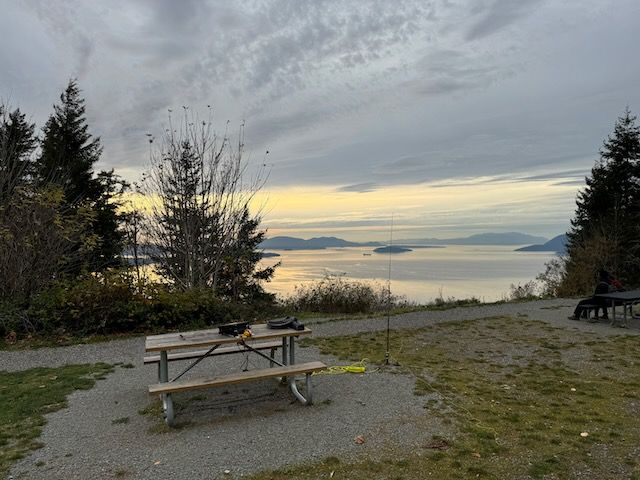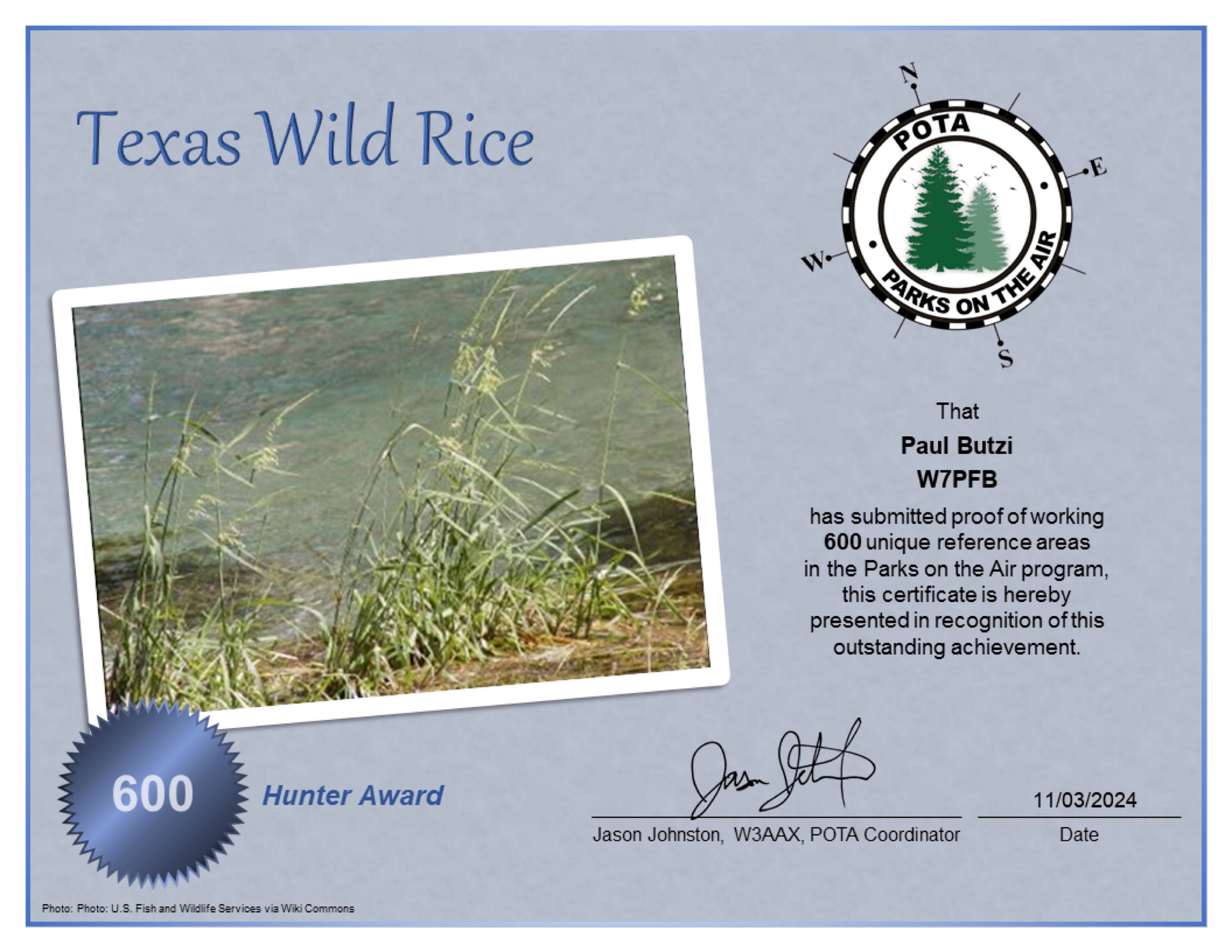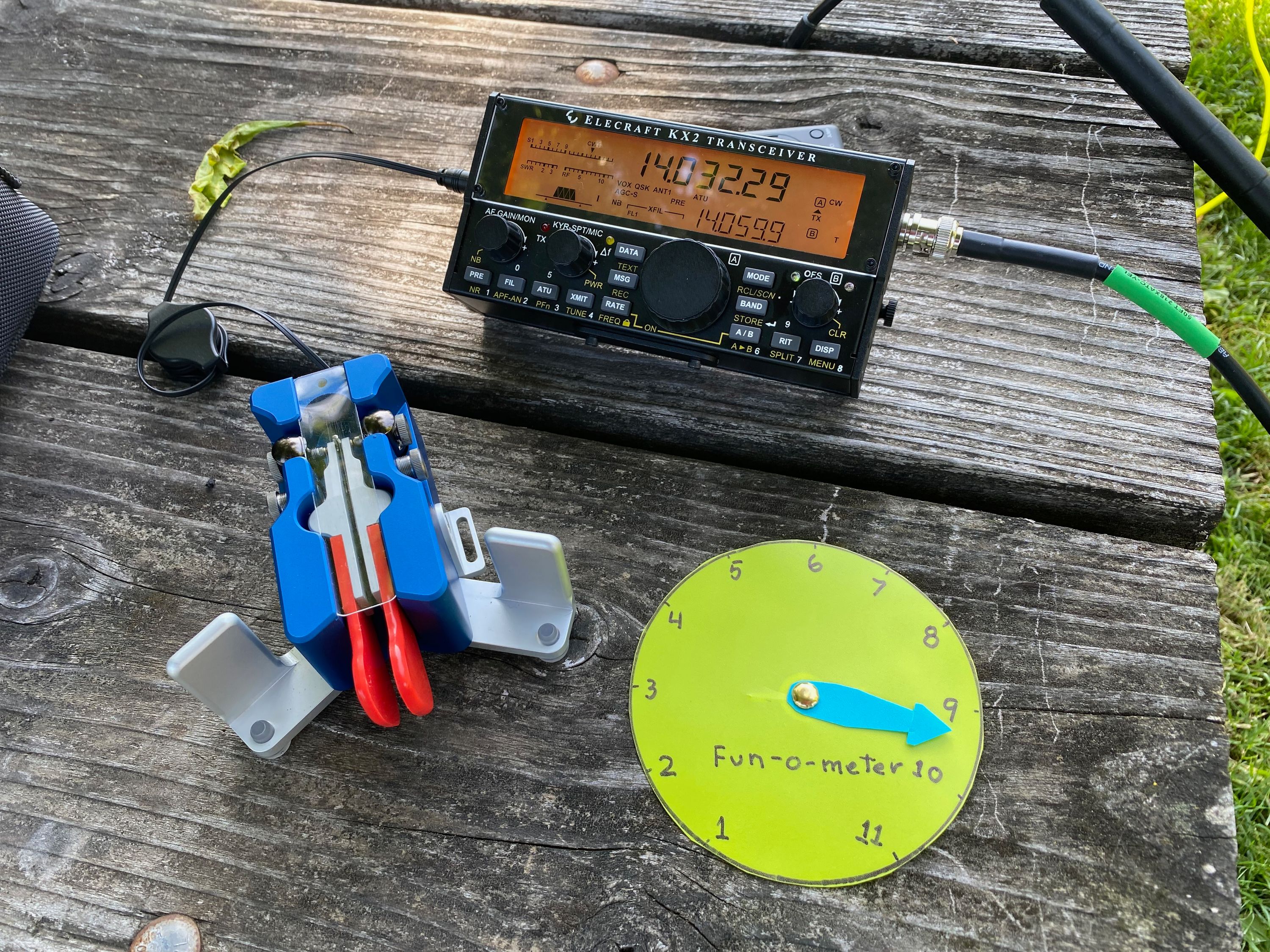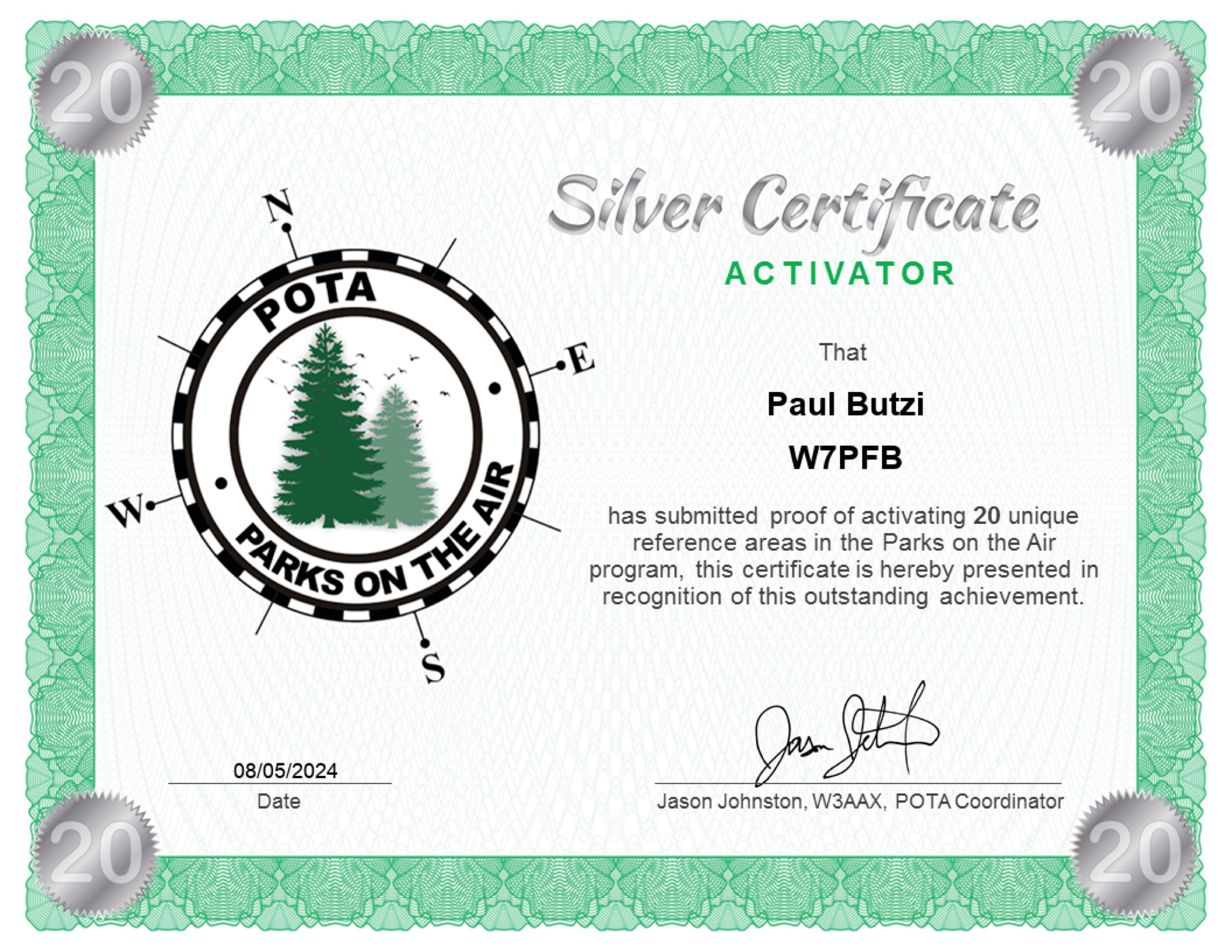One Year of Parks on the Air

I made my very first POTA QSO on October 4, 2023. I did my first POTA park activation on October 30, 2023. Prompted by a desire to hunt (and then activate) using CW, I made my first POTA CW QSO on November 30, 2023.
So I am a little over a year of POTA in the hunter role, just a smidgen past a year as an activator, and not quite a year playing POTA using CW. It seems a good time to look back over that experience.
Hunting

I think I found out about POTA because I stumbled across one of Thomas Witherspoon’s low key videos of him doing a park activation. I was completely mesmerized by him sitting at a picnic table, tiny radio in front of him, key in his left fist, rite-in-the-rain notepad and pencil for logging, contentedly chatting with the camera while cranking out one CW QSO after another. No sooner did I finish watching that video than I was looking at the POTA website, and I think I must have seen that there were people activating using digital modes, SSB phone, and CW, and headed straight to the shack to see if I could give it a whirl.
My logbook shows the first ten or so POTA QSO’s were FT8. In retrospect, I’m amazed, because I’ve never much cared for FT8. The answer, of course, is that the modes I preferred then were PSK and Olivia, and pretty much no one activates using those modes. And I couldn’t do CW, so it boiled down to FT8/4, or SSB. And at that time, I didn’t much care for SSB.
Digital
I’m a big fan of conversational digital modes. I’ve got more than a thousand PSK QSOs in my log, along with many many MFSK16, Olivia, Contestia, Domino, etc. Qs.
What I am not a fan of are the FT modes. I appreciate the ability to work very very weak stations, but the predetermined structure of the QSO, the inability to add even the skimpiest personalization of the QSO, and the automated progression of the exchange all run strongly against the grain for me.
I understand the point people are making when they say that PSK QSOs are typically made with both operators clicking macro buttons on their screen. I will grant that. But I will observe that most PSK operators hit the macro button and then amend the transmit text window before they hit ‘transmit’. Certainly that was my practice. And it’s perfectly possible to ragchew in PSK, or any of the other modes I like. Indeed, I have three PSK31 QSO’s longer than half an hour.
So although the first POTA QSOs I did were FT8/FT4, it didn’t take long before my dislike of FT modes pushed me into another mode I didn’t much care for: SSB.
SSB
To do SSB QSOs for POTA, I actually had to make some minor rearrangements in my shack. The first few SSB Qs, I did on my IC-7300. It’s a fine transceiver, but given my desire to still do the occasional FT QSO, I rapidly got tired of switching modes back and forth on the IC-7300, and so I hooked the headset up to my KX3/KXPA100, put the KX3 in SSB mode, and just switched the antenna back and forth at the patch panel depending on which transceiver I wanted to use.
I was a pretty inept SSB operator at the start of all this. It didn’t take long, however, before those skills started to improve, and as I got better and started to feel a bit more confident, I started to enjoy SSB more and more.
At the end of October I felt confident enough to take a swing at doing a park activation using SSB.
CW

While all this was going on, I was still watching Thomas K4SWL’s wonderful videos, and I began to feel an itch to give CW a whirl. At that point, I had some modest abilities at character recognition, but it was clear I couldn’t copy nor send well enough to actually pull off a QSO.
So I started to practice copying, using various activation videos to start to understand how a typical CW POTA QSO went, and starting to recognize the obvious parts. Just about the time I could recognize the parts of the QSO by ear, I started thinking about how I might overcome my very massive key fright.
As I have explained before, in the end I programmed the memories on my KX3 so that I could ‘cheat’ my way through a CW QSO. And that’s what I did - I made perhaps a dozen QSO’s before I screwed up my courage to the sticking place and actually tried sending using the key. At this point I was still relying heavily on the CW decode feature of my KX3.
As the CW proponents tell everyone, getting on the air turned out to be the best path to having less terrible CW skills. I was slowly relying less and less on the KX3 decode, feeling more and more confident in my sending skills.
At some point, watching the K4SWL videos pushed me into deciding I wanted to work toward doing QRP picnic table activations. There were a lot of things I didn’t understand about what that would involve, but I felt clear that I wanted to be doing it using CW at some point. I was also convinced that I needed to build my CW skills to do that, so I decided to work only CW when hunting. Slowly but surely my CW skills began to improve.
The thing about building your CW skills is that it seems to go very slowly at first, and then very suddenly you find yourself hearing “good afternoon” and “thank you” and “good luck” instead of dits and dahs, and likewise you are hearing “five five nine” or “five two nine” instead of dits and dahs, and instead of working only the stations that are quite loud, you are working stations that are down close to the noise. Instead of sending the minimal “BK 5NN 5NN WA WA BK” you find yourself sending “BK GA JIM UR 53N 53N WA WA TU ES GL 73 BK” without much thinking hard.
Not quite a year into this intensive effort I’m not yet ready for extended CW ragchews. But I do remember the first time Jim WB0RLJ tripped me up when I responded to his CQ by sending me “GM PAUL”, when I was expecting GM, and it took me several seconds before I “PAUL” was actually my name. And now the vocabulary of words I recognize when I hear them, as opposed to laboriously getting them letter by letter, is growing.
In January I did an activation on the east coast with the help of my cousin using CW. I still couldn’t copy callsigns as they came in, but with someone to log for me and feed me the callsigns, I managed to stumble my way through 8 activation QSO in CW.
Activating

I did my first park activation on October 30, 2023. I’d been thinking hard about trying an activation from the time I first started hunting, but it seemed to me to be a daunting proposition. I’d worked portable before, doing PSK31 from the back seat of my car. My last attempt to pull that off ended badly, with a failed magmount and no backup for the antenna meaning I was shut out completely.
But I really wanted to give it a whirl, so I was making lists, trying to anticipate all the possible problems. Of course, there are so many things that can go wrong, especially as I had no idea about how to log, no idea about how to handle spotting, and absolutely no experience doing SSB in the field.
But in the end, after several weeks of planning paralysis, I decided the only way to do it was to chuck caution to the wind, throw a lot of gear into the car, and take a swing at it. If it didn’t work out, I figured I’d at least learn what I needed to do differently the next time.
SSB
My first activation was SSB. I’d never experienced anything even remotely like that first activation. I got 37 contacts in the space of 34 minutes of operating. It was as if a whirlwind had blown through my brain.
My logging was a mess. I had one caller where when I got home, I couldn’t read the callsign in my log. If you’re that caller, I’m really sorry about that.
But it was so much fun. It was clear from the start that I was hooked. The problems that prevented me from doing more activations were that the weather was slowly turning nasty, and I needed all my time to get in high running volumes to train for a six day footrace that started on Dec 29 and ran to January 3. Between the weather and training, no activations.
And then after the race, my Dad fell ill and was hospitalized. Off I went to Pennsylvania, where 100% of my time was supporting my Mom.
And then in March, I took four days and combined a big POTA rove with a trip to Boise, ID. During that trip I did 11 SSB activations of 10 parks. By the end of that, I had enough experience that I no longer considered doing activations to be a huge challenge, and I started aiming at using CW.
CW
After my the memorial service for my Dad, my cousin and I sloped off to activate Brandywine Creek State Park, and in that activation, my cousin Curt coached me through a handful of CW QSOs, making that the first activation where I did CW.
I wouldn’t have been able to do that activation without the huge CW assist from Curt, K7ZOO. But what it did was convince me that doing CW during activations was something I wanted to do, and something that, given my skills at that point, was not quite within my reach but at the same time not impossibly distant.
So I ramped up CW practice, and I got busy working on my weak point - copying callsigns - and steadily my skills improved. By June, I was doing CW unassisted during my activations. By late June, I was doing enough CW that I felt I could do a CW only activation and get enough contacts to validate the activation.
I’ve not yet done a CW only activation, but less than a year after starting I no longer have an anxiety attack as I set up the KX2 to do CW during an activation.
Digital
After a couple of activations during periods where propagation was perfectly awful, I started thinking about digital modes, which offer both better QSO rates and better ability to work even in very rough conditions.
I bought a Digirig interface for the G90, and then one for the KX2.
I did one activation entirely with FT8. FT8 gets the job done but I don’t much enjoy it.
So for now, I think digital modes are either going to be used:
- as a rescue measure, to get a valid activation when SSB and CW are coming up short
- as an experiment, when I might do PSK31 just to try to promote the idea that there are conversation digital modes which would be great for POTA activations.
Car/Picnic Table
My first activations were done from the confines of my car. After the big rove, though, I was pretty sick of being in the car, and so I was determined to get out of the car and out into the park.
I was also determined to make doing an activation less of a big production and more of an I’m done my appointment early, let’s see if there’s a nearby park I can activate sort of thing.
To that end, I bought a car radio that, while portable, can just live in the car all the time. The radio I chose, a Xiegu G90, is fine for that task but has some shortcomings, so a different radio may well take up that role (current thoughts are along the lines of a Yaesu FT-891).
The more I work from picnic tables, the more I enjoy it. You can chose a picnic table with a great view, or one well away from other park users.
As winter sets in here in the Pacific Northwest, though, I’m thinking more and more about how to deal with rain. One option is to work from picnic shelters, which are generally unused when it’s cold and rainy. And I bought a Kelty Backroads tent-like shelter that attaches to the car, so that I can work outside the car but still use it for support.
Time will tell.

